Literature Review: Social Media's Impact on Youth Mental Wellbeing
VerifiedAdded on 2022/10/15
|9
|2464
|33
Literature Review
AI Summary
This literature review, authored by Knaggs Felisme for Monroe College under the guidance of Dr. Altamirano, explores the multifaceted impacts of social media on youth. It delves into the extensive time young people spend online, examining its effects on mental and physical health, and socio-ecological development. The review highlights social media's role in youth activism, citing examples like the 'Me Too' campaign and political movements, while acknowledging criticisms about translating online activism into real-world action. Furthermore, the study investigates the adverse effects of social media on mental health, including negative body image, stress, cyberbullying, and the association between social media usage and increased levels of depression and anxiety. It also discusses the impact of sedentary lifestyles and social media on physical health, including potential links to non-communicable diseases. Finally, the review addresses the issue of youth violence, including online bullying and the influence of social media on homicide rates, referencing the Blue Whale Challenge and other harmful online trends.
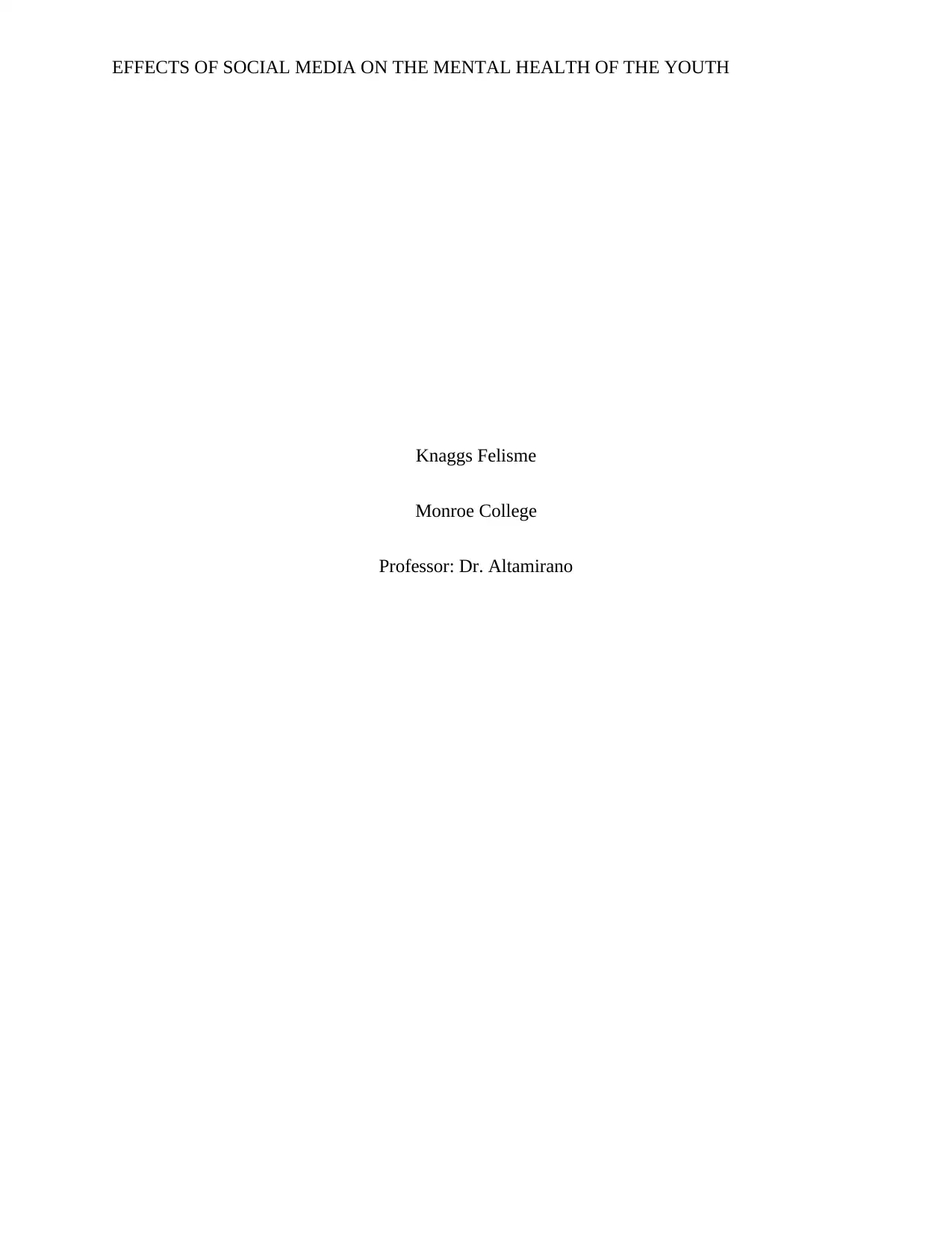
EFFECTS OF SOCIAL MEDIA ON THE MENTAL HEALTH OF THE YOUTH
Knaggs Felisme
Monroe College
Professor: Dr. Altamirano
Knaggs Felisme
Monroe College
Professor: Dr. Altamirano
Paraphrase This Document
Need a fresh take? Get an instant paraphrase of this document with our AI Paraphraser
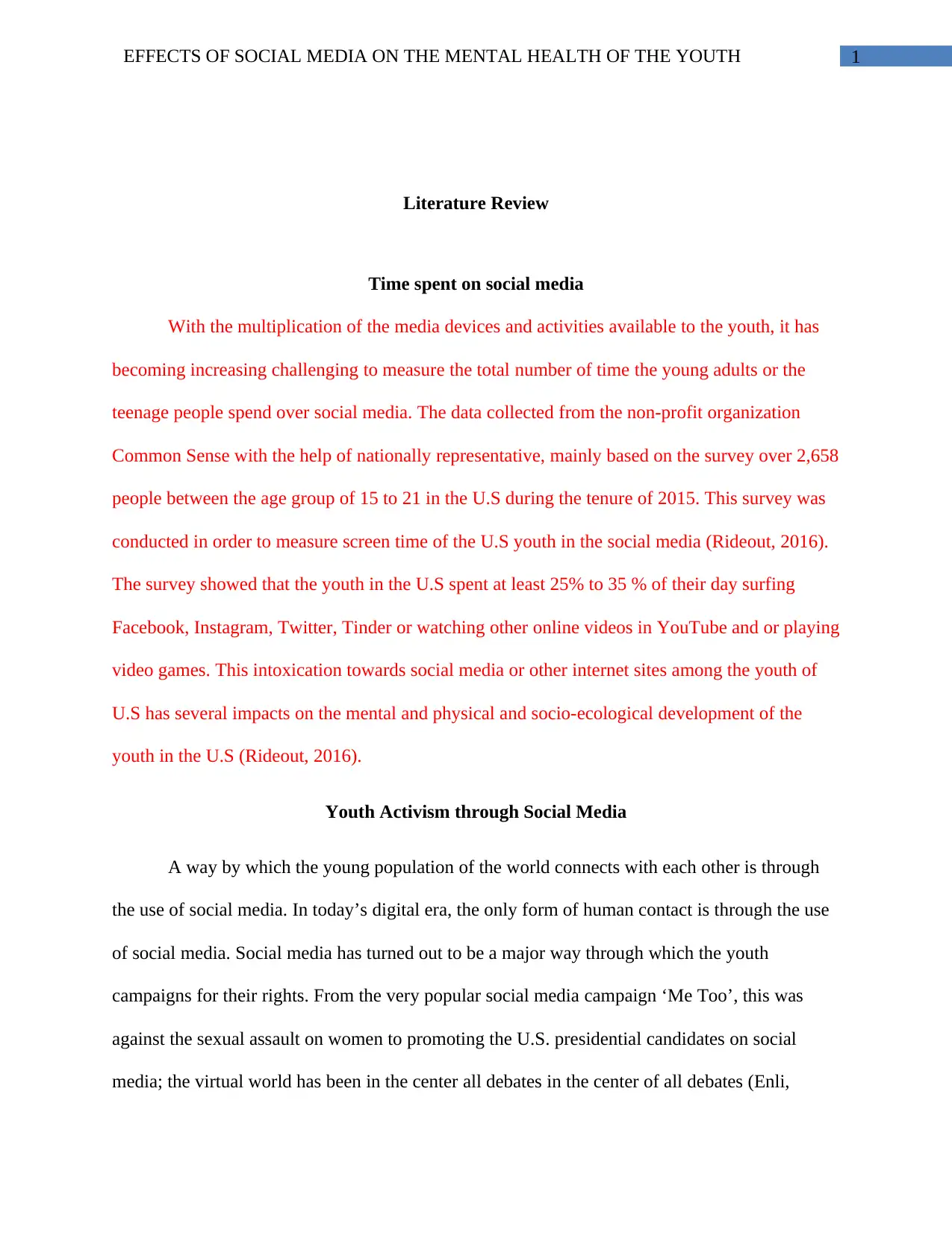
1EFFECTS OF SOCIAL MEDIA ON THE MENTAL HEALTH OF THE YOUTH
Literature Review
Time spent on social media
With the multiplication of the media devices and activities available to the youth, it has
becoming increasing challenging to measure the total number of time the young adults or the
teenage people spend over social media. The data collected from the non-profit organization
Common Sense with the help of nationally representative, mainly based on the survey over 2,658
people between the age group of 15 to 21 in the U.S during the tenure of 2015. This survey was
conducted in order to measure screen time of the U.S youth in the social media (Rideout, 2016).
The survey showed that the youth in the U.S spent at least 25% to 35 % of their day surfing
Facebook, Instagram, Twitter, Tinder or watching other online videos in YouTube and or playing
video games. This intoxication towards social media or other internet sites among the youth of
U.S has several impacts on the mental and physical and socio-ecological development of the
youth in the U.S (Rideout, 2016).
Youth Activism through Social Media
A way by which the young population of the world connects with each other is through
the use of social media. In today’s digital era, the only form of human contact is through the use
of social media. Social media has turned out to be a major way through which the youth
campaigns for their rights. From the very popular social media campaign ‘Me Too’, this was
against the sexual assault on women to promoting the U.S. presidential candidates on social
media; the virtual world has been in the center all debates in the center of all debates (Enli,
Literature Review
Time spent on social media
With the multiplication of the media devices and activities available to the youth, it has
becoming increasing challenging to measure the total number of time the young adults or the
teenage people spend over social media. The data collected from the non-profit organization
Common Sense with the help of nationally representative, mainly based on the survey over 2,658
people between the age group of 15 to 21 in the U.S during the tenure of 2015. This survey was
conducted in order to measure screen time of the U.S youth in the social media (Rideout, 2016).
The survey showed that the youth in the U.S spent at least 25% to 35 % of their day surfing
Facebook, Instagram, Twitter, Tinder or watching other online videos in YouTube and or playing
video games. This intoxication towards social media or other internet sites among the youth of
U.S has several impacts on the mental and physical and socio-ecological development of the
youth in the U.S (Rideout, 2016).
Youth Activism through Social Media
A way by which the young population of the world connects with each other is through
the use of social media. In today’s digital era, the only form of human contact is through the use
of social media. Social media has turned out to be a major way through which the youth
campaigns for their rights. From the very popular social media campaign ‘Me Too’, this was
against the sexual assault on women to promoting the U.S. presidential candidates on social
media; the virtual world has been in the center all debates in the center of all debates (Enli,
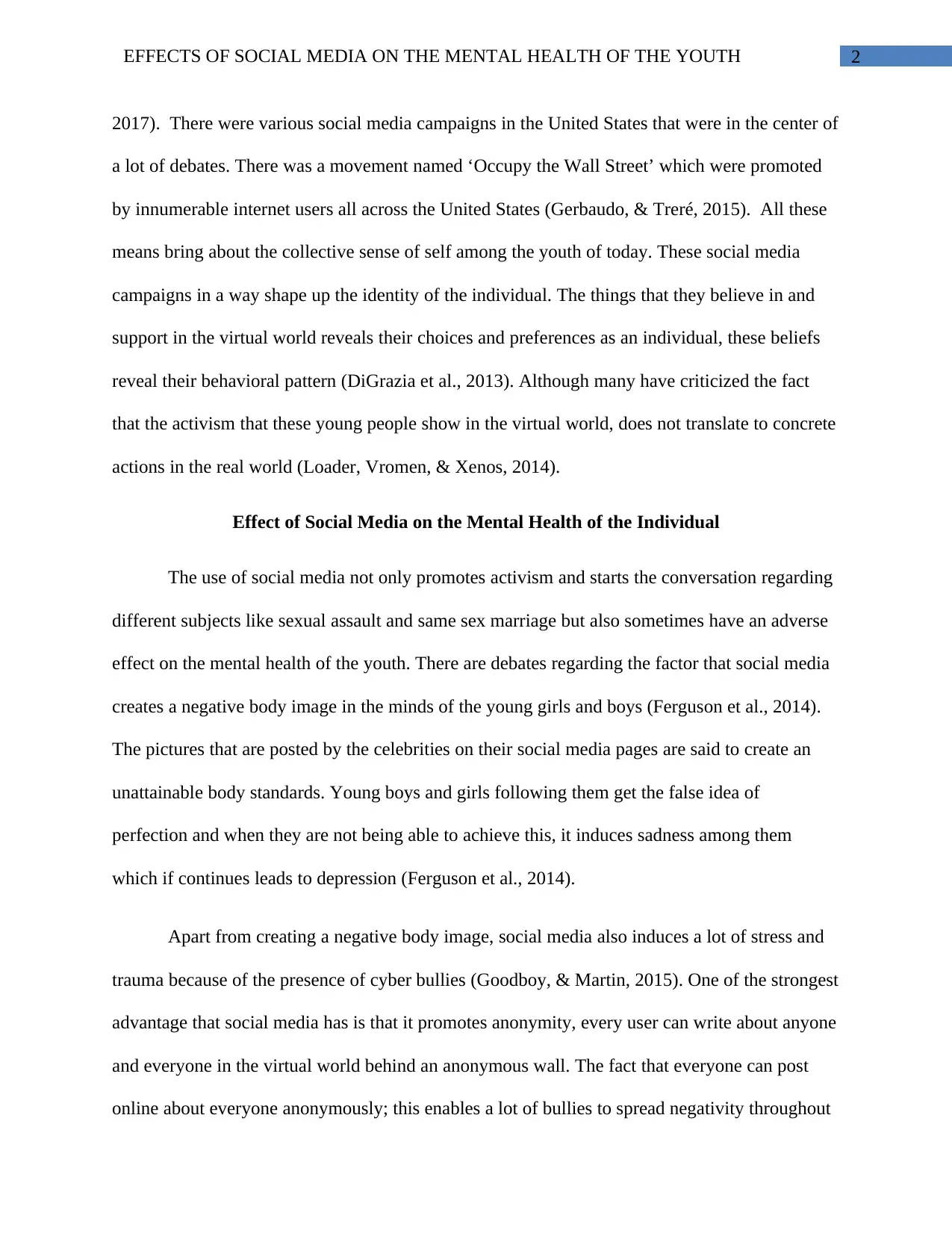
2EFFECTS OF SOCIAL MEDIA ON THE MENTAL HEALTH OF THE YOUTH
2017). There were various social media campaigns in the United States that were in the center of
a lot of debates. There was a movement named ‘Occupy the Wall Street’ which were promoted
by innumerable internet users all across the United States (Gerbaudo, & Treré, 2015). All these
means bring about the collective sense of self among the youth of today. These social media
campaigns in a way shape up the identity of the individual. The things that they believe in and
support in the virtual world reveals their choices and preferences as an individual, these beliefs
reveal their behavioral pattern (DiGrazia et al., 2013). Although many have criticized the fact
that the activism that these young people show in the virtual world, does not translate to concrete
actions in the real world (Loader, Vromen, & Xenos, 2014).
Effect of Social Media on the Mental Health of the Individual
The use of social media not only promotes activism and starts the conversation regarding
different subjects like sexual assault and same sex marriage but also sometimes have an adverse
effect on the mental health of the youth. There are debates regarding the factor that social media
creates a negative body image in the minds of the young girls and boys (Ferguson et al., 2014).
The pictures that are posted by the celebrities on their social media pages are said to create an
unattainable body standards. Young boys and girls following them get the false idea of
perfection and when they are not being able to achieve this, it induces sadness among them
which if continues leads to depression (Ferguson et al., 2014).
Apart from creating a negative body image, social media also induces a lot of stress and
trauma because of the presence of cyber bullies (Goodboy, & Martin, 2015). One of the strongest
advantage that social media has is that it promotes anonymity, every user can write about anyone
and everyone in the virtual world behind an anonymous wall. The fact that everyone can post
online about everyone anonymously; this enables a lot of bullies to spread negativity throughout
2017). There were various social media campaigns in the United States that were in the center of
a lot of debates. There was a movement named ‘Occupy the Wall Street’ which were promoted
by innumerable internet users all across the United States (Gerbaudo, & Treré, 2015). All these
means bring about the collective sense of self among the youth of today. These social media
campaigns in a way shape up the identity of the individual. The things that they believe in and
support in the virtual world reveals their choices and preferences as an individual, these beliefs
reveal their behavioral pattern (DiGrazia et al., 2013). Although many have criticized the fact
that the activism that these young people show in the virtual world, does not translate to concrete
actions in the real world (Loader, Vromen, & Xenos, 2014).
Effect of Social Media on the Mental Health of the Individual
The use of social media not only promotes activism and starts the conversation regarding
different subjects like sexual assault and same sex marriage but also sometimes have an adverse
effect on the mental health of the youth. There are debates regarding the factor that social media
creates a negative body image in the minds of the young girls and boys (Ferguson et al., 2014).
The pictures that are posted by the celebrities on their social media pages are said to create an
unattainable body standards. Young boys and girls following them get the false idea of
perfection and when they are not being able to achieve this, it induces sadness among them
which if continues leads to depression (Ferguson et al., 2014).
Apart from creating a negative body image, social media also induces a lot of stress and
trauma because of the presence of cyber bullies (Goodboy, & Martin, 2015). One of the strongest
advantage that social media has is that it promotes anonymity, every user can write about anyone
and everyone in the virtual world behind an anonymous wall. The fact that everyone can post
online about everyone anonymously; this enables a lot of bullies to spread negativity throughout
⊘ This is a preview!⊘
Do you want full access?
Subscribe today to unlock all pages.

Trusted by 1+ million students worldwide
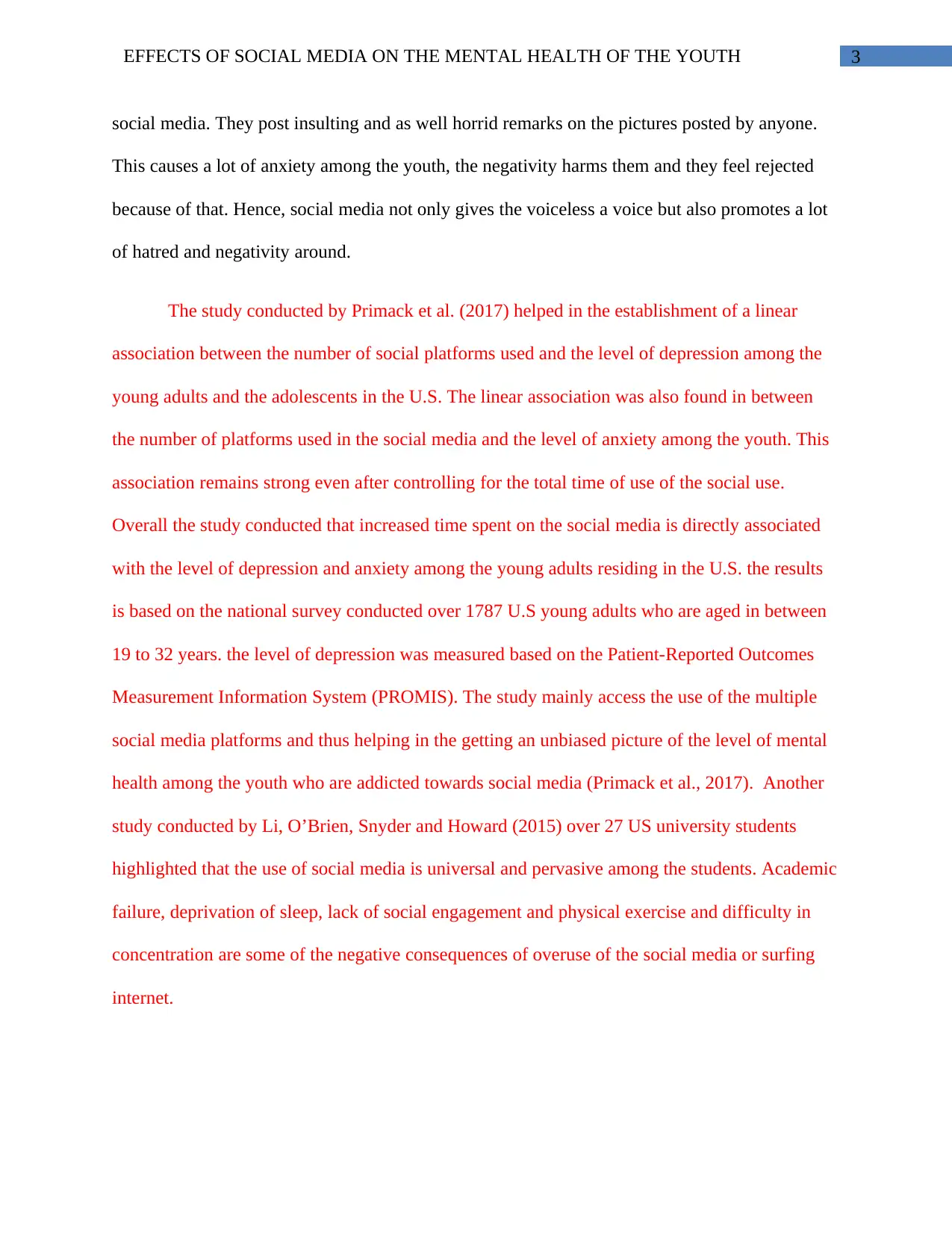
3EFFECTS OF SOCIAL MEDIA ON THE MENTAL HEALTH OF THE YOUTH
social media. They post insulting and as well horrid remarks on the pictures posted by anyone.
This causes a lot of anxiety among the youth, the negativity harms them and they feel rejected
because of that. Hence, social media not only gives the voiceless a voice but also promotes a lot
of hatred and negativity around.
The study conducted by Primack et al. (2017) helped in the establishment of a linear
association between the number of social platforms used and the level of depression among the
young adults and the adolescents in the U.S. The linear association was also found in between
the number of platforms used in the social media and the level of anxiety among the youth. This
association remains strong even after controlling for the total time of use of the social use.
Overall the study conducted that increased time spent on the social media is directly associated
with the level of depression and anxiety among the young adults residing in the U.S. the results
is based on the national survey conducted over 1787 U.S young adults who are aged in between
19 to 32 years. the level of depression was measured based on the Patient-Reported Outcomes
Measurement Information System (PROMIS). The study mainly access the use of the multiple
social media platforms and thus helping in the getting an unbiased picture of the level of mental
health among the youth who are addicted towards social media (Primack et al., 2017). Another
study conducted by Li, O’Brien, Snyder and Howard (2015) over 27 US university students
highlighted that the use of social media is universal and pervasive among the students. Academic
failure, deprivation of sleep, lack of social engagement and physical exercise and difficulty in
concentration are some of the negative consequences of overuse of the social media or surfing
internet.
social media. They post insulting and as well horrid remarks on the pictures posted by anyone.
This causes a lot of anxiety among the youth, the negativity harms them and they feel rejected
because of that. Hence, social media not only gives the voiceless a voice but also promotes a lot
of hatred and negativity around.
The study conducted by Primack et al. (2017) helped in the establishment of a linear
association between the number of social platforms used and the level of depression among the
young adults and the adolescents in the U.S. The linear association was also found in between
the number of platforms used in the social media and the level of anxiety among the youth. This
association remains strong even after controlling for the total time of use of the social use.
Overall the study conducted that increased time spent on the social media is directly associated
with the level of depression and anxiety among the young adults residing in the U.S. the results
is based on the national survey conducted over 1787 U.S young adults who are aged in between
19 to 32 years. the level of depression was measured based on the Patient-Reported Outcomes
Measurement Information System (PROMIS). The study mainly access the use of the multiple
social media platforms and thus helping in the getting an unbiased picture of the level of mental
health among the youth who are addicted towards social media (Primack et al., 2017). Another
study conducted by Li, O’Brien, Snyder and Howard (2015) over 27 US university students
highlighted that the use of social media is universal and pervasive among the students. Academic
failure, deprivation of sleep, lack of social engagement and physical exercise and difficulty in
concentration are some of the negative consequences of overuse of the social media or surfing
internet.
Paraphrase This Document
Need a fresh take? Get an instant paraphrase of this document with our AI Paraphraser
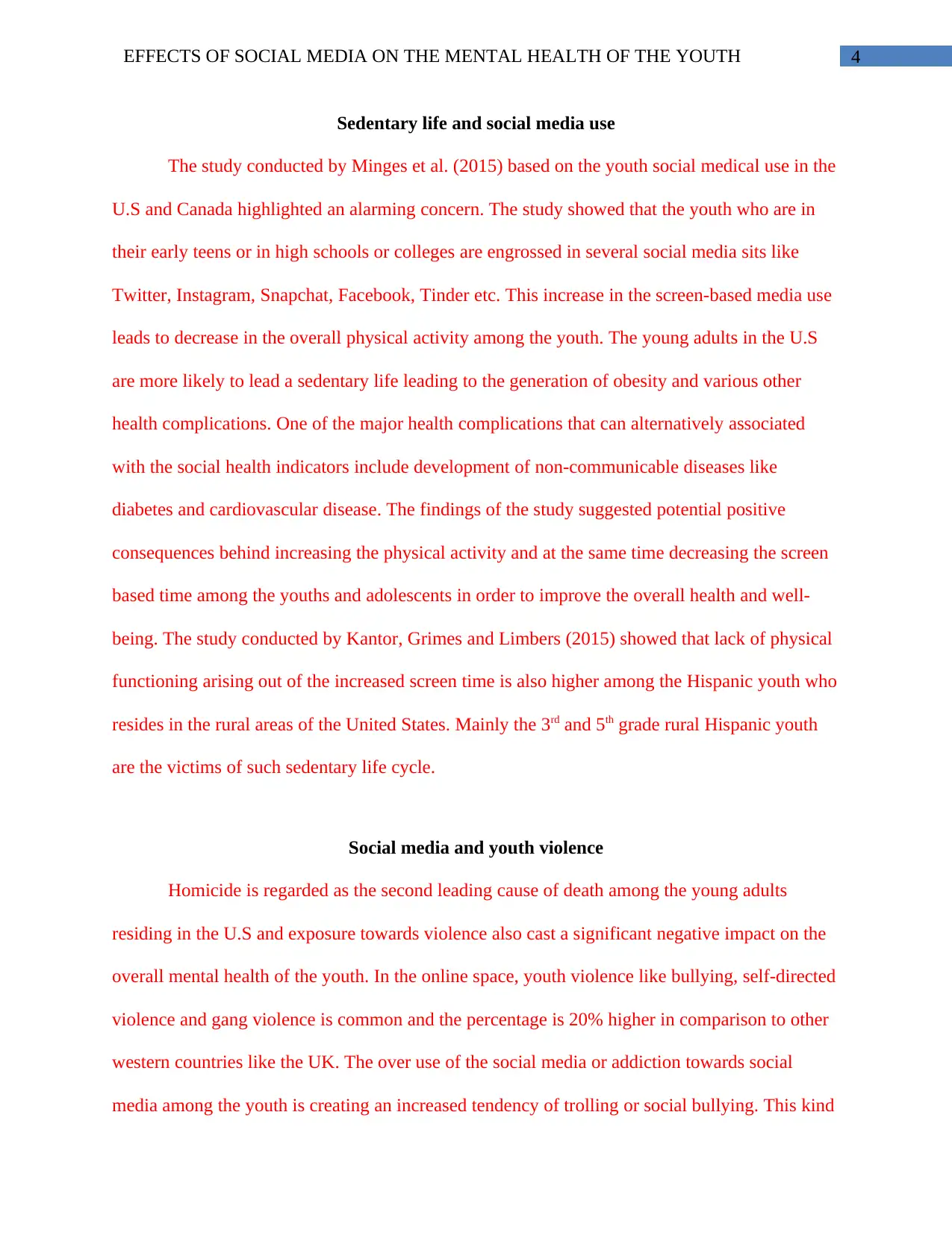
4EFFECTS OF SOCIAL MEDIA ON THE MENTAL HEALTH OF THE YOUTH
Sedentary life and social media use
The study conducted by Minges et al. (2015) based on the youth social medical use in the
U.S and Canada highlighted an alarming concern. The study showed that the youth who are in
their early teens or in high schools or colleges are engrossed in several social media sits like
Twitter, Instagram, Snapchat, Facebook, Tinder etc. This increase in the screen-based media use
leads to decrease in the overall physical activity among the youth. The young adults in the U.S
are more likely to lead a sedentary life leading to the generation of obesity and various other
health complications. One of the major health complications that can alternatively associated
with the social health indicators include development of non-communicable diseases like
diabetes and cardiovascular disease. The findings of the study suggested potential positive
consequences behind increasing the physical activity and at the same time decreasing the screen
based time among the youths and adolescents in order to improve the overall health and well-
being. The study conducted by Kantor, Grimes and Limbers (2015) showed that lack of physical
functioning arising out of the increased screen time is also higher among the Hispanic youth who
resides in the rural areas of the United States. Mainly the 3rd and 5th grade rural Hispanic youth
are the victims of such sedentary life cycle.
Social media and youth violence
Homicide is regarded as the second leading cause of death among the young adults
residing in the U.S and exposure towards violence also cast a significant negative impact on the
overall mental health of the youth. In the online space, youth violence like bullying, self-directed
violence and gang violence is common and the percentage is 20% higher in comparison to other
western countries like the UK. The over use of the social media or addiction towards social
media among the youth is creating an increased tendency of trolling or social bullying. This kind
Sedentary life and social media use
The study conducted by Minges et al. (2015) based on the youth social medical use in the
U.S and Canada highlighted an alarming concern. The study showed that the youth who are in
their early teens or in high schools or colleges are engrossed in several social media sits like
Twitter, Instagram, Snapchat, Facebook, Tinder etc. This increase in the screen-based media use
leads to decrease in the overall physical activity among the youth. The young adults in the U.S
are more likely to lead a sedentary life leading to the generation of obesity and various other
health complications. One of the major health complications that can alternatively associated
with the social health indicators include development of non-communicable diseases like
diabetes and cardiovascular disease. The findings of the study suggested potential positive
consequences behind increasing the physical activity and at the same time decreasing the screen
based time among the youths and adolescents in order to improve the overall health and well-
being. The study conducted by Kantor, Grimes and Limbers (2015) showed that lack of physical
functioning arising out of the increased screen time is also higher among the Hispanic youth who
resides in the rural areas of the United States. Mainly the 3rd and 5th grade rural Hispanic youth
are the victims of such sedentary life cycle.
Social media and youth violence
Homicide is regarded as the second leading cause of death among the young adults
residing in the U.S and exposure towards violence also cast a significant negative impact on the
overall mental health of the youth. In the online space, youth violence like bullying, self-directed
violence and gang violence is common and the percentage is 20% higher in comparison to other
western countries like the UK. The over use of the social media or addiction towards social
media among the youth is creating an increased tendency of trolling or social bullying. This kind
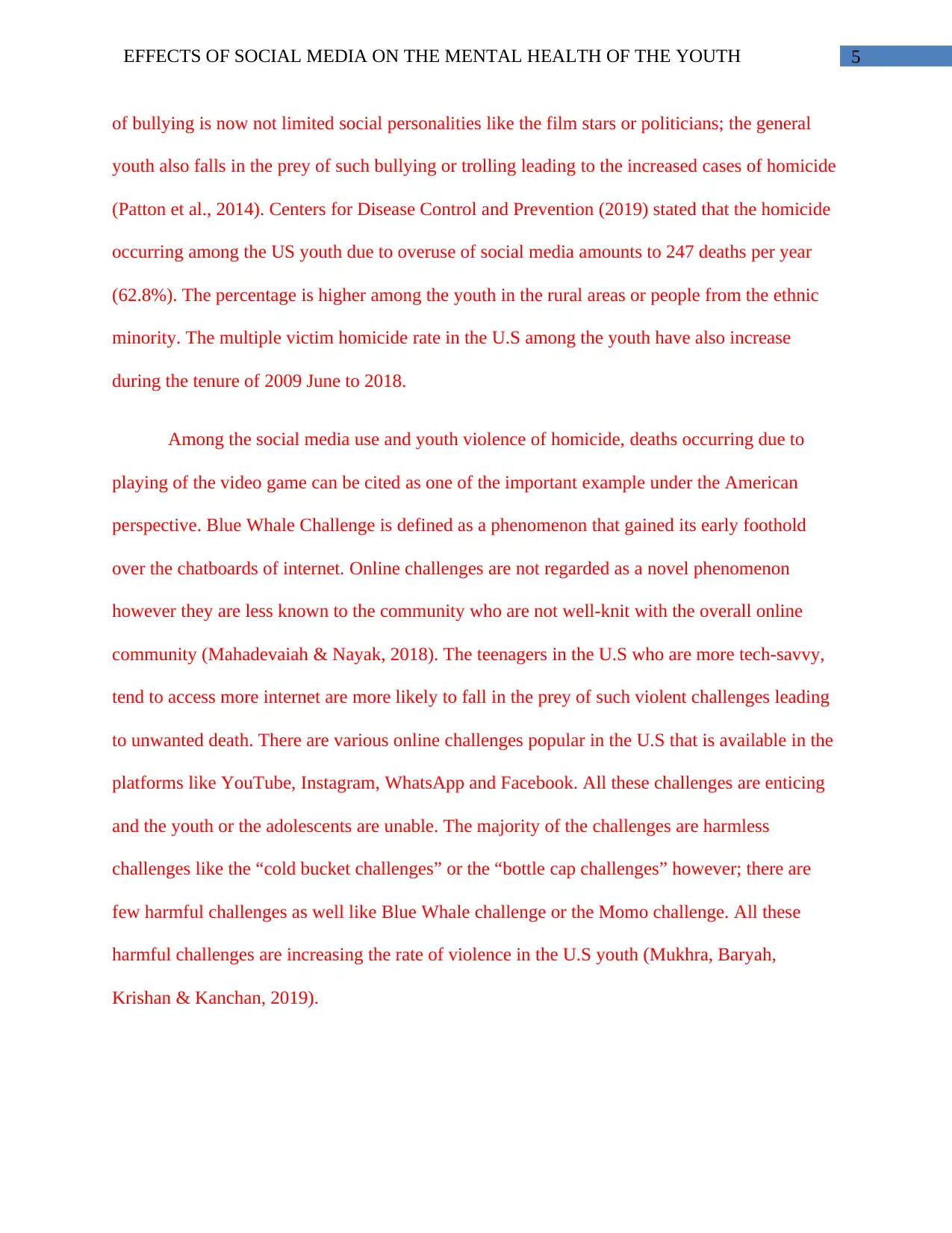
5EFFECTS OF SOCIAL MEDIA ON THE MENTAL HEALTH OF THE YOUTH
of bullying is now not limited social personalities like the film stars or politicians; the general
youth also falls in the prey of such bullying or trolling leading to the increased cases of homicide
(Patton et al., 2014). Centers for Disease Control and Prevention (2019) stated that the homicide
occurring among the US youth due to overuse of social media amounts to 247 deaths per year
(62.8%). The percentage is higher among the youth in the rural areas or people from the ethnic
minority. The multiple victim homicide rate in the U.S among the youth have also increase
during the tenure of 2009 June to 2018.
Among the social media use and youth violence of homicide, deaths occurring due to
playing of the video game can be cited as one of the important example under the American
perspective. Blue Whale Challenge is defined as a phenomenon that gained its early foothold
over the chatboards of internet. Online challenges are not regarded as a novel phenomenon
however they are less known to the community who are not well-knit with the overall online
community (Mahadevaiah & Nayak, 2018). The teenagers in the U.S who are more tech-savvy,
tend to access more internet are more likely to fall in the prey of such violent challenges leading
to unwanted death. There are various online challenges popular in the U.S that is available in the
platforms like YouTube, Instagram, WhatsApp and Facebook. All these challenges are enticing
and the youth or the adolescents are unable. The majority of the challenges are harmless
challenges like the “cold bucket challenges” or the “bottle cap challenges” however; there are
few harmful challenges as well like Blue Whale challenge or the Momo challenge. All these
harmful challenges are increasing the rate of violence in the U.S youth (Mukhra, Baryah,
Krishan & Kanchan, 2019).
of bullying is now not limited social personalities like the film stars or politicians; the general
youth also falls in the prey of such bullying or trolling leading to the increased cases of homicide
(Patton et al., 2014). Centers for Disease Control and Prevention (2019) stated that the homicide
occurring among the US youth due to overuse of social media amounts to 247 deaths per year
(62.8%). The percentage is higher among the youth in the rural areas or people from the ethnic
minority. The multiple victim homicide rate in the U.S among the youth have also increase
during the tenure of 2009 June to 2018.
Among the social media use and youth violence of homicide, deaths occurring due to
playing of the video game can be cited as one of the important example under the American
perspective. Blue Whale Challenge is defined as a phenomenon that gained its early foothold
over the chatboards of internet. Online challenges are not regarded as a novel phenomenon
however they are less known to the community who are not well-knit with the overall online
community (Mahadevaiah & Nayak, 2018). The teenagers in the U.S who are more tech-savvy,
tend to access more internet are more likely to fall in the prey of such violent challenges leading
to unwanted death. There are various online challenges popular in the U.S that is available in the
platforms like YouTube, Instagram, WhatsApp and Facebook. All these challenges are enticing
and the youth or the adolescents are unable. The majority of the challenges are harmless
challenges like the “cold bucket challenges” or the “bottle cap challenges” however; there are
few harmful challenges as well like Blue Whale challenge or the Momo challenge. All these
harmful challenges are increasing the rate of violence in the U.S youth (Mukhra, Baryah,
Krishan & Kanchan, 2019).
⊘ This is a preview!⊘
Do you want full access?
Subscribe today to unlock all pages.

Trusted by 1+ million students worldwide
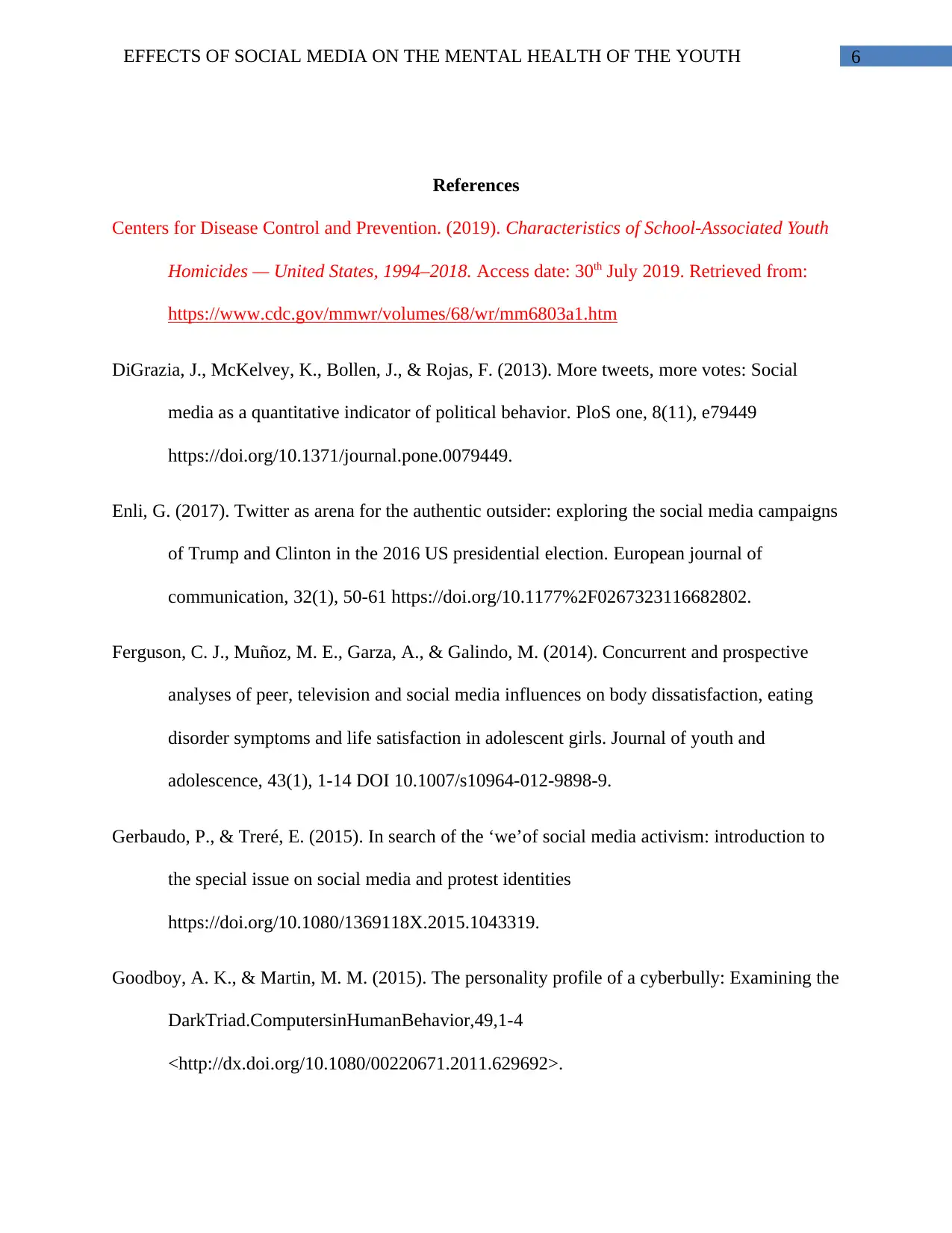
6EFFECTS OF SOCIAL MEDIA ON THE MENTAL HEALTH OF THE YOUTH
References
Centers for Disease Control and Prevention. (2019). Characteristics of School-Associated Youth
Homicides — United States, 1994–2018. Access date: 30th July 2019. Retrieved from:
https://www.cdc.gov/mmwr/volumes/68/wr/mm6803a1.htm
DiGrazia, J., McKelvey, K., Bollen, J., & Rojas, F. (2013). More tweets, more votes: Social
media as a quantitative indicator of political behavior. PloS one, 8(11), e79449
https://doi.org/10.1371/journal.pone.0079449.
Enli, G. (2017). Twitter as arena for the authentic outsider: exploring the social media campaigns
of Trump and Clinton in the 2016 US presidential election. European journal of
communication, 32(1), 50-61 https://doi.org/10.1177%2F0267323116682802.
Ferguson, C. J., Muñoz, M. E., Garza, A., & Galindo, M. (2014). Concurrent and prospective
analyses of peer, television and social media influences on body dissatisfaction, eating
disorder symptoms and life satisfaction in adolescent girls. Journal of youth and
adolescence, 43(1), 1-14 DOI 10.1007/s10964-012-9898-9.
Gerbaudo, P., & Treré, E. (2015). In search of the ‘we’of social media activism: introduction to
the special issue on social media and protest identities
https://doi.org/10.1080/1369118X.2015.1043319.
Goodboy, A. K., & Martin, M. M. (2015). The personality profile of a cyberbully: Examining the
DarkTriad.ComputersinHumanBehavior,49,1-4
<http://dx.doi.org/10.1080/00220671.2011.629692>.
References
Centers for Disease Control and Prevention. (2019). Characteristics of School-Associated Youth
Homicides — United States, 1994–2018. Access date: 30th July 2019. Retrieved from:
https://www.cdc.gov/mmwr/volumes/68/wr/mm6803a1.htm
DiGrazia, J., McKelvey, K., Bollen, J., & Rojas, F. (2013). More tweets, more votes: Social
media as a quantitative indicator of political behavior. PloS one, 8(11), e79449
https://doi.org/10.1371/journal.pone.0079449.
Enli, G. (2017). Twitter as arena for the authentic outsider: exploring the social media campaigns
of Trump and Clinton in the 2016 US presidential election. European journal of
communication, 32(1), 50-61 https://doi.org/10.1177%2F0267323116682802.
Ferguson, C. J., Muñoz, M. E., Garza, A., & Galindo, M. (2014). Concurrent and prospective
analyses of peer, television and social media influences on body dissatisfaction, eating
disorder symptoms and life satisfaction in adolescent girls. Journal of youth and
adolescence, 43(1), 1-14 DOI 10.1007/s10964-012-9898-9.
Gerbaudo, P., & Treré, E. (2015). In search of the ‘we’of social media activism: introduction to
the special issue on social media and protest identities
https://doi.org/10.1080/1369118X.2015.1043319.
Goodboy, A. K., & Martin, M. M. (2015). The personality profile of a cyberbully: Examining the
DarkTriad.ComputersinHumanBehavior,49,1-4
<http://dx.doi.org/10.1080/00220671.2011.629692>.
Paraphrase This Document
Need a fresh take? Get an instant paraphrase of this document with our AI Paraphraser
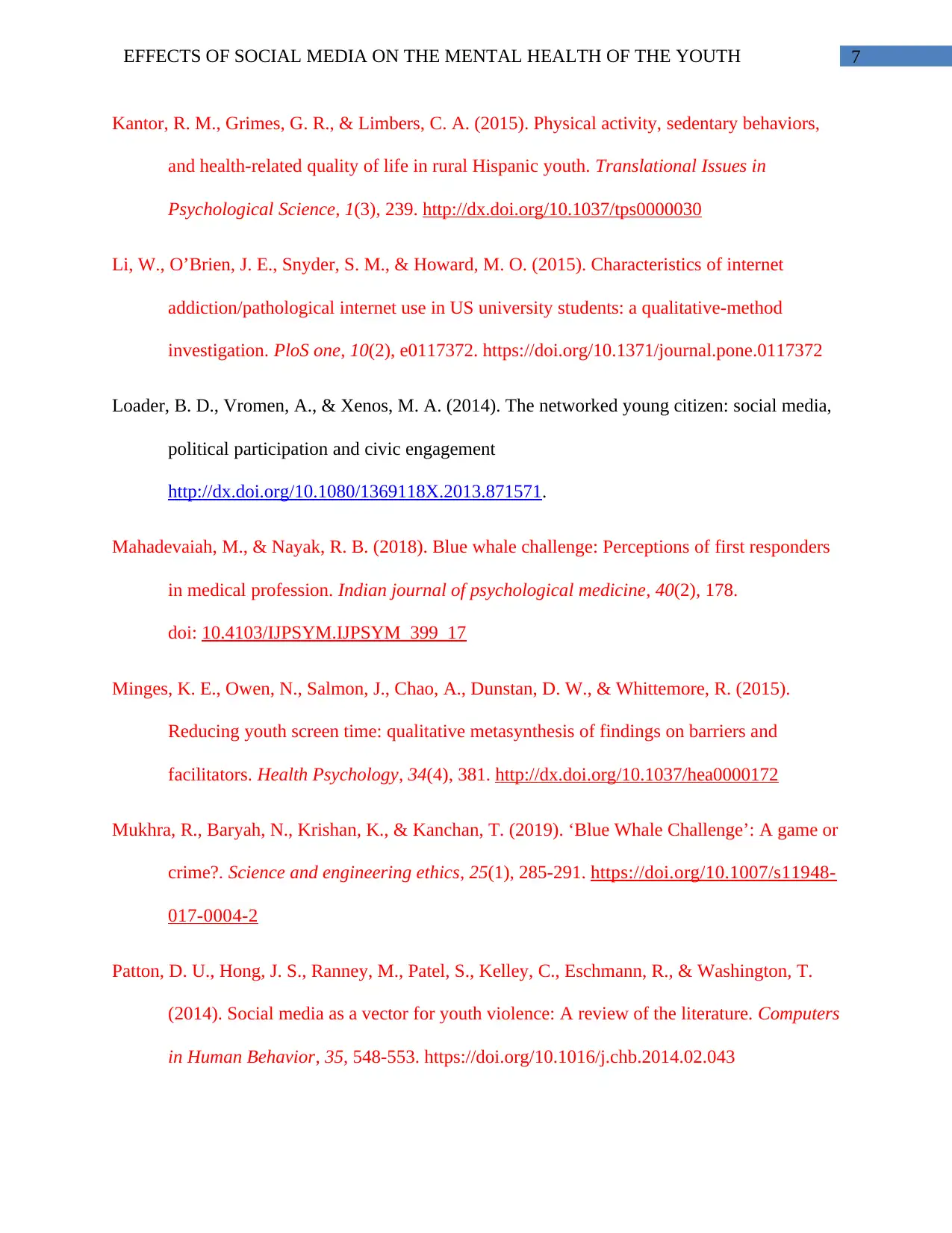
7EFFECTS OF SOCIAL MEDIA ON THE MENTAL HEALTH OF THE YOUTH
Kantor, R. M., Grimes, G. R., & Limbers, C. A. (2015). Physical activity, sedentary behaviors,
and health-related quality of life in rural Hispanic youth. Translational Issues in
Psychological Science, 1(3), 239. http://dx.doi.org/10.1037/tps0000030
Li, W., O’Brien, J. E., Snyder, S. M., & Howard, M. O. (2015). Characteristics of internet
addiction/pathological internet use in US university students: a qualitative-method
investigation. PloS one, 10(2), e0117372. https://doi.org/10.1371/journal.pone.0117372
Loader, B. D., Vromen, A., & Xenos, M. A. (2014). The networked young citizen: social media,
political participation and civic engagement
http://dx.doi.org/10.1080/1369118X.2013.871571.
Mahadevaiah, M., & Nayak, R. B. (2018). Blue whale challenge: Perceptions of first responders
in medical profession. Indian journal of psychological medicine, 40(2), 178.
doi: 10.4103/IJPSYM.IJPSYM_399_17
Minges, K. E., Owen, N., Salmon, J., Chao, A., Dunstan, D. W., & Whittemore, R. (2015).
Reducing youth screen time: qualitative metasynthesis of findings on barriers and
facilitators. Health Psychology, 34(4), 381. http://dx.doi.org/10.1037/hea0000172
Mukhra, R., Baryah, N., Krishan, K., & Kanchan, T. (2019). ‘Blue Whale Challenge’: A game or
crime?. Science and engineering ethics, 25(1), 285-291. https://doi.org/10.1007/s11948-
017-0004-2
Patton, D. U., Hong, J. S., Ranney, M., Patel, S., Kelley, C., Eschmann, R., & Washington, T.
(2014). Social media as a vector for youth violence: A review of the literature. Computers
in Human Behavior, 35, 548-553. https://doi.org/10.1016/j.chb.2014.02.043
Kantor, R. M., Grimes, G. R., & Limbers, C. A. (2015). Physical activity, sedentary behaviors,
and health-related quality of life in rural Hispanic youth. Translational Issues in
Psychological Science, 1(3), 239. http://dx.doi.org/10.1037/tps0000030
Li, W., O’Brien, J. E., Snyder, S. M., & Howard, M. O. (2015). Characteristics of internet
addiction/pathological internet use in US university students: a qualitative-method
investigation. PloS one, 10(2), e0117372. https://doi.org/10.1371/journal.pone.0117372
Loader, B. D., Vromen, A., & Xenos, M. A. (2014). The networked young citizen: social media,
political participation and civic engagement
http://dx.doi.org/10.1080/1369118X.2013.871571.
Mahadevaiah, M., & Nayak, R. B. (2018). Blue whale challenge: Perceptions of first responders
in medical profession. Indian journal of psychological medicine, 40(2), 178.
doi: 10.4103/IJPSYM.IJPSYM_399_17
Minges, K. E., Owen, N., Salmon, J., Chao, A., Dunstan, D. W., & Whittemore, R. (2015).
Reducing youth screen time: qualitative metasynthesis of findings on barriers and
facilitators. Health Psychology, 34(4), 381. http://dx.doi.org/10.1037/hea0000172
Mukhra, R., Baryah, N., Krishan, K., & Kanchan, T. (2019). ‘Blue Whale Challenge’: A game or
crime?. Science and engineering ethics, 25(1), 285-291. https://doi.org/10.1007/s11948-
017-0004-2
Patton, D. U., Hong, J. S., Ranney, M., Patel, S., Kelley, C., Eschmann, R., & Washington, T.
(2014). Social media as a vector for youth violence: A review of the literature. Computers
in Human Behavior, 35, 548-553. https://doi.org/10.1016/j.chb.2014.02.043
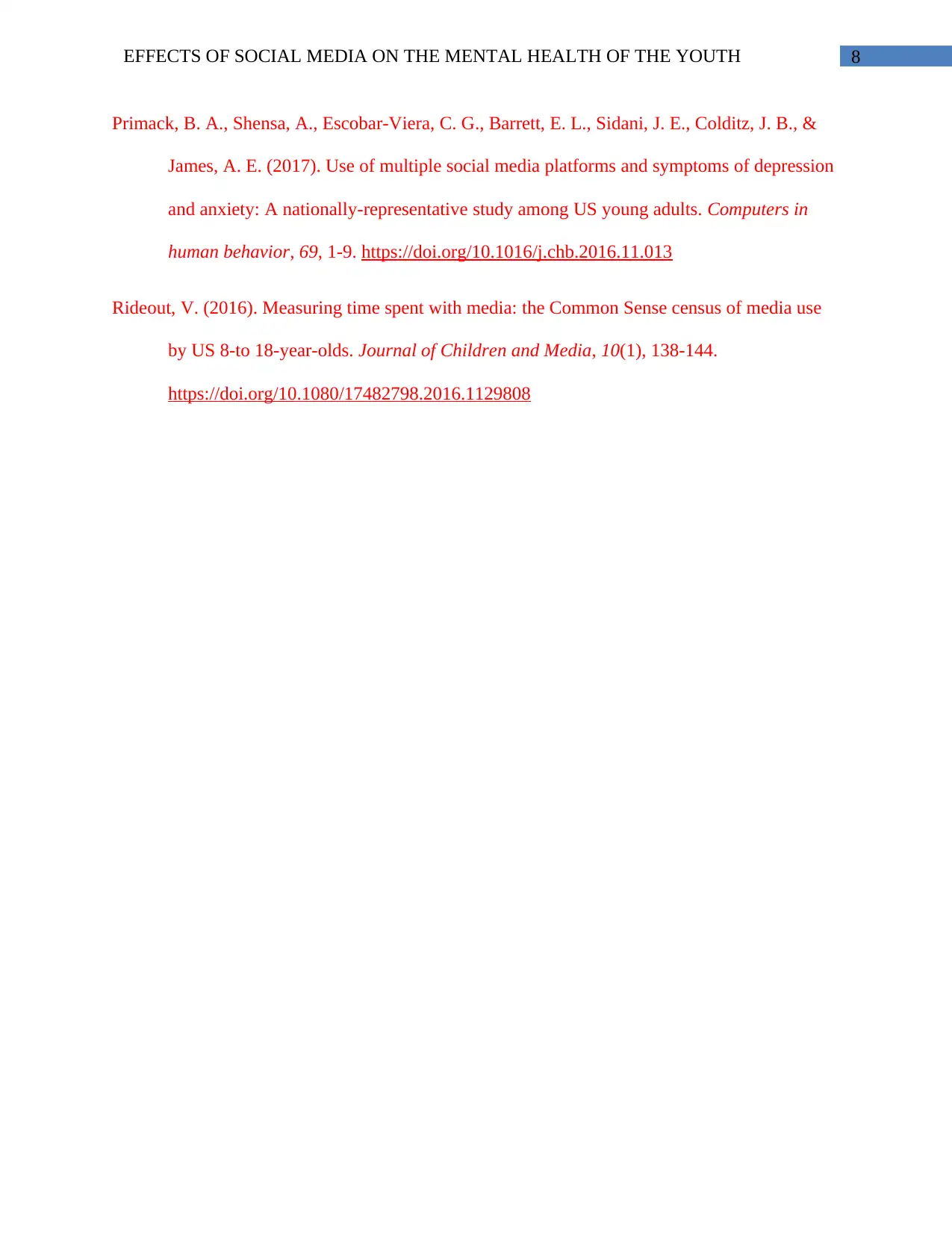
8EFFECTS OF SOCIAL MEDIA ON THE MENTAL HEALTH OF THE YOUTH
Primack, B. A., Shensa, A., Escobar-Viera, C. G., Barrett, E. L., Sidani, J. E., Colditz, J. B., &
James, A. E. (2017). Use of multiple social media platforms and symptoms of depression
and anxiety: A nationally-representative study among US young adults. Computers in
human behavior, 69, 1-9. https://doi.org/10.1016/j.chb.2016.11.013
Rideout, V. (2016). Measuring time spent with media: the Common Sense census of media use
by US 8-to 18-year-olds. Journal of Children and Media, 10(1), 138-144.
https://doi.org/10.1080/17482798.2016.1129808
Primack, B. A., Shensa, A., Escobar-Viera, C. G., Barrett, E. L., Sidani, J. E., Colditz, J. B., &
James, A. E. (2017). Use of multiple social media platforms and symptoms of depression
and anxiety: A nationally-representative study among US young adults. Computers in
human behavior, 69, 1-9. https://doi.org/10.1016/j.chb.2016.11.013
Rideout, V. (2016). Measuring time spent with media: the Common Sense census of media use
by US 8-to 18-year-olds. Journal of Children and Media, 10(1), 138-144.
https://doi.org/10.1080/17482798.2016.1129808
⊘ This is a preview!⊘
Do you want full access?
Subscribe today to unlock all pages.

Trusted by 1+ million students worldwide
1 out of 9
Related Documents
Your All-in-One AI-Powered Toolkit for Academic Success.
+13062052269
info@desklib.com
Available 24*7 on WhatsApp / Email
![[object Object]](/_next/static/media/star-bottom.7253800d.svg)
Unlock your academic potential
Copyright © 2020–2025 A2Z Services. All Rights Reserved. Developed and managed by ZUCOL.




